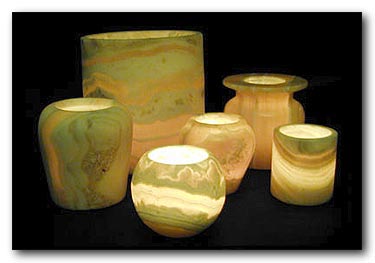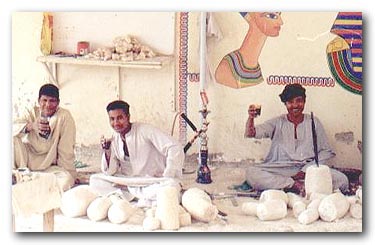Alabaster: Egypt’s Rock of Ages
By: Sonny S.
Seventy-year-old Mohamed Ahmed Abdallah smiles broadly as he watches that big truck unloading alabaster rocks in front of his alabaster factory on the west bank of Luxor. Times are changing, yet he still remembers the "old days," when he was riding on donkeys with his father, into the mountains of the Western Desert, following the trail of the old alabaster road, seeking that magnificent rock in almost inaccessible valleys. Today’s trucks do that job.
You cannot talk about Egypt without mentioning Alabaster, an artistic handicraft that boasts a millenniums old history and a noble tradition that can be felt in almost every nook and cranny of the country. The secrets of the manufacture of this warm and luminous stone have been handed down from generation to generation, throughout the ages, and still represent one of the pinnacles of Egyptian handicrafts.
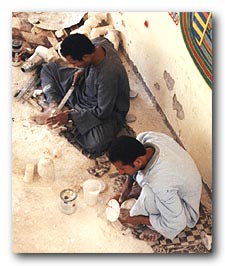 |
Alabaster is quarried either in open pits or underground. In open pits, veins of Alabaster are found 12 to 20 feet below the surface under a layer of shale which can be two or three feet deep. The rocks have an average height of 16-20 inches and a diameter of two to three feet. Rarely do the rocks exceed these sizes. This material is a mineral product of two fine masters, father Time and mother Earth. It requires both to achieve the fine grain of its smooth white translucent stone. Working the alabaster quarries is a laborious, unpredictable job.
Alabaster is ageless. It is found throughout the histories of Sumer, Babylon and Assyria and of course, Egypt. Deposits of alabaster are not only found in Egypt also in countries like Algeria, England, United States, Belgium, India, Turkey, Spain, Cyprus, and Italy.
Alabaster is a fine-grained, massive, translucent variety of gypsum, a hydrous calcium sulphate. It is pure white or streaked with reddish brown. Like all other forms of gypsum, alabaster forms by the evaporation of bedded deposits that are precipitated mainly from evaporating seawater. It is soft enough to be scratched with a fingernail and hence it is easily broken, soiled, and weathered. Because of its softness, alabaster is often carved for statuary and other decorative purposes. The often-used term "Oriental Alabaster" is a misnomer and actually refers to marble, a calcium carbonate, whereas gypsum is a calcium
sulphate.
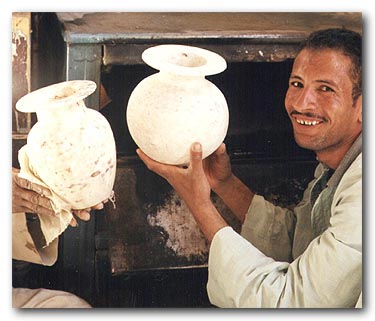 |
So we do know two different kinds of Alabaster: the gypsum kind, which is used mainly for pure hand-made products and the "Oriental Alabaster" which is a much harder stone, similar to marble, and which today is only used for machine-made products.
"Oriental alabaster" (marble) was extensively used by the Egyptians in sarcophagi, in the linings of tombs, in the walls and ceilings of temples, and in vases and sacrificial vessels.
As a raw material (Gypsum Alabaster), it is a crystalline material (hydrated calcium sulphate - gypsum-), with off-white colour, translucent, density 2.350 kg/m3 and a Mohs Hardness of 2,3 to 2,5. Iron, copper and other minerals native to the quarry area were introduced in solution, giving the stone its exquisite colours, which distinguish Upper Egypt’s alabaster from other deposits on this planet. Each vein of alabaster has its own unique colour and characteristics. It is found in nature in bulky, irregular shapes, in different sizes and variable depths, mixed with other materials like marls or clays which protect alabaster against exterior agents.
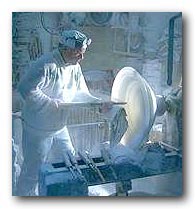 |
Stonework with alabaster was one of Egypt's earliest industries (4000 BC). Two ancient alabaster sites are known. One site was at Wadi Gerawi, and the other at Helwan. Oriental alabaster (marble or calcium carbonate) was very popular during Egypt's New Kingdom. The working of hard stone reached it's height during the Third and Fourth Dynasties, 2600-2400 BC. Early vessels were of simple but elegant shape, often with flat board rims. Calcite was believed to have, in a mythical sense, solar connections.
Products obtained from alabaster stone have had a very diverse historic evolution; Firstly, the Egyptians and also the Greek and Chinese cultures used it to make artisan products. Afterwards, it was used around the world in altarpieces of churches and monasteries and mosques. In modern times Muhammad Ali used it for his Alabaster mosque in the citadel of Cairo.
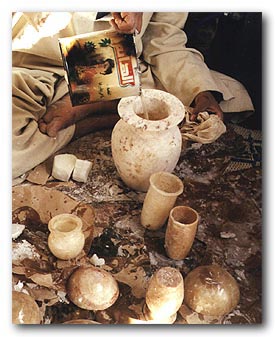 |
At the beginning of last century, ART DECO and ART-NOUVEAU designers used it for the first time as diffuser of light to design decorative fitting, taking advantage of its transparency and natural graining. In the middle of the 80´s, the recovery of DECO´s style in interior design boosted the re-introduction of alabaster as a material, competing with crystal and other acrylic materials, and mainly contributing, as novelty, the fact that it was a "natural product made by hand".
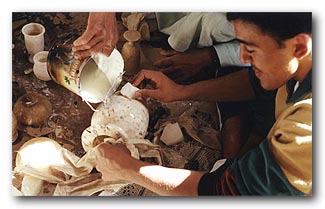 |
Several millenniums have passed since the ancient Egyptians began to work with alabaster and in spite of various problems Egyptian artisans have not lost the knowledge of how to handle this material. Even though branch of industry no longer represents the most important factor of the economy in Egypt, it is still a characteristic element of its culture and its history. There aren’t many artisans left "knowing how to handle" Alabaster. It’s up to men like Mohamed Ahmed Abdallah and his colleagues in Cairo and in Luxor/Westbank/Qurna to preserve this old tradition and to keep this handicraft going for future generations.
